The National Institute of General Medical Sciences (NIGMS) has new resources on Pinterest! Follow NIGMS and access engaging science education materials, including virtual learning activities, scientific images, basic science articles, and more.
Continue reading “Check Out Our Pinterest Board of Virtual Learning STEM Resources”Category: Being a Scientist
Explore Our Virtual Learning STEM Resources
If you’re looking for engaging ways to teach science from home, NIGMS offers a range of resources that can help.
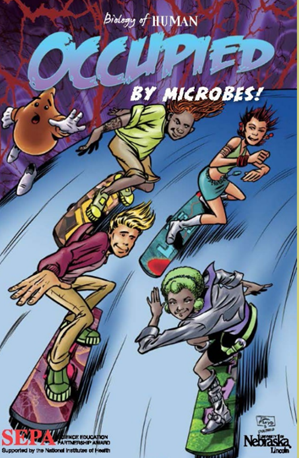 A SEPA-funded resource about microbes. Credit: University of Nebraska, Lincoln.
A SEPA-funded resource about microbes. Credit: University of Nebraska, Lincoln.
Our Science Education and Partnership Award (SEPA) webpage features free, easy-to-access STEM and informal science education projects for pre-K through grade 12. Aligned with state and national standards for STEM teaching and learning, the program has tools such as:
- Apps
- Interactives
- Online books
- Curricula and lesson plans
- Short movies
Students can learn about sleep, cells, growth, microbes, a healthy lifestyle, genetics, and many other subjects.
Continue reading “Explore Our Virtual Learning STEM Resources”PECASE Honoree James Olzmann Investigates the Secrets of Lipid Droplets
Note to our Biomedical Beat readers: Echoing the sentiments NIH Director Francis Collins made on his blog, NIGMS is making every effort during the COVID-19 pandemic to keep supporting the best and most powerful science. In that spirit, we’ll continue to bring you stories across a wide range of NIGMS topics. We hope these posts offer a respite from the coronavirus news when needed.
 A cell nucleus (blue) surrounded by lipid droplets (yellow). Credit: James Olzmann.
A cell nucleus (blue) surrounded by lipid droplets (yellow). Credit: James Olzmann.
Within our cells, lipids are often stored in droplets, membrane-bound packages of lipids produced by the endoplasmic reticulum. For many years, scientists thought lipid droplets were simple globs of fat and rarely studied them. But over the past few decades, research has revealed that they’re full-fledged organelles, or specialized structures that perform important cellular functions. The field of lipid droplet research has been growing ever since.
Continue reading “PECASE Honoree James Olzmann Investigates the Secrets of Lipid Droplets”Pathways: The Circadian Rhythms Issue
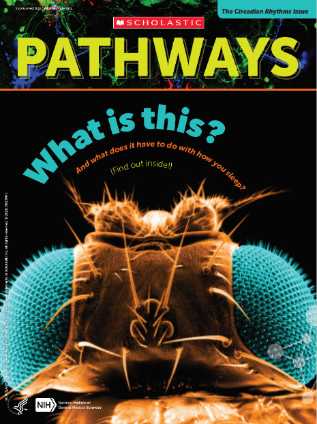 Cover of Pathways student magazine.
Cover of Pathways student magazine.
NIGMS and Scholastic, Inc., bring you the third edition of Pathways, a collection of free resources that teaches students about basic science and its importance to health, and exciting research careers.
Pathways is designed for grades 6 through 12. The topic of this unit is circadian rhythms, the “schedules” our bodies follow over the course of a day. These rhythms influence processes like hunger and the sleep-wake cycle.
Continue reading “Pathways: The Circadian Rhythms Issue”PECASE Honoree Sohini Ramachandran Studies the Genetic Foundations of Traits in Diverse Populations
 Sohini Ramachandran, Brown University.
Sohini Ramachandran, Brown University.Credit: Danish Saroee/Swedish Collegium for Advanced Study.
Recent advances in computing enable researchers to explore the life sciences in ways that would have been impossible a few decades ago. One new tool is the ability to sequence genomes, revealing people’s full DNA blueprints. The collection of more and more genetic data allows researchers to compare the DNA of many people and observe variations, including those shared by people with a common ancestry.
Sohini Ramachandran, Ph.D., is director of the Center for Computational Molecular Biology and associate professor of biology and computer science at Brown University in Providence, Rhode Island. She is also a recent recipient of the Presidential Early Career Award for Scientists and Engineers (PECASE). Dr. Ramachandran researches the causes and consequences of human genetic variations using computer models. Starting with genomic data from living people, her lab applies statistical methods, mathematical modeling, and computer simulations to discover how human populations moved and changed genetically over time.
Continue reading “PECASE Honoree Sohini Ramachandran Studies the Genetic Foundations of Traits in Diverse Populations”PECASE Honoree Michael Boyce on Sugar’s Role in Cell Signaling and on Diversity, Equity, and Inclusion in the Scientific Workforce
 Michael Boyce, associate professor of biochemistry at Duke University in Durham, North Carolina. Credit: Michael Boyce.
Michael Boyce, associate professor of biochemistry at Duke University in Durham, North Carolina. Credit: Michael Boyce.
Sugars aren’t merely energy sources for our cells. They also play important signaling roles through a process called glycosylation, where they attach to proteins and lipids as tags. Although these sugar tags, called glycans, impact many cellular processes, they have long been understudied due to technical challenges. Now, advances in analytical tools like mass spectrometry are enabling scientists to examine the enormous complexity of glycans. Other advances also allow researchers to synthesize complex sugars, providing them with standards for analytical experiments.
Continue reading “PECASE Honoree Michael Boyce on Sugar’s Role in Cell Signaling and on Diversity, Equity, and Inclusion in the Scientific Workforce”Looking Back at the Top Three Posts of 2019
Over the past 12 months, we’ve explored a variety of topics in genetics, cell biology, chemistry, and careers in the biomedical sciences. As we ring in the new year, we bring you our top three posts of 2019. If your favorite is missing, let us know what it is in the comments section below!
Amazing Organisms and the Lessons They Can Teach Us
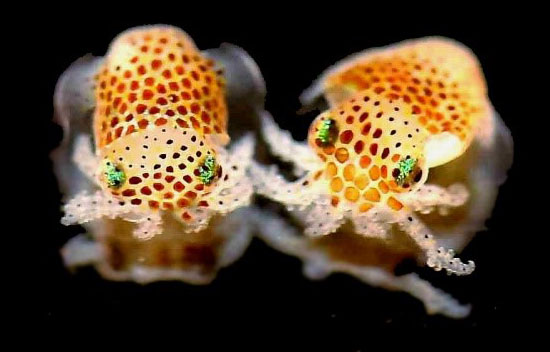 Hawaiian bobtail squid. Credit: Dr. Satoshi Shibata.
Hawaiian bobtail squid. Credit: Dr. Satoshi Shibata.
Studying research organisms, such as those featured in this post, teaches us about ourselves. These amazing creatures, which have some traits similar to our own, may hold the key to preventing and treating an array of complex diseases.
Continue reading “Looking Back at the Top Three Posts of 2019”The Meat of the Matter: Learning How Gut Microbiota Might Reduce Harm from Red Meat
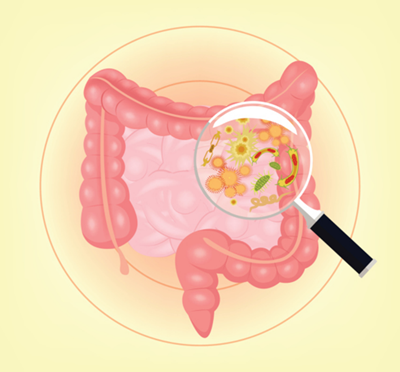 Microbiota in the intestines. Credit: iStock.
Microbiota in the intestines. Credit: iStock.Research on how diet impacts the gut microbiota has rapidly expanded in the last several years. Studies show that diets rich in red meat are linked to diseases such as colon cancer and heart disease. In both mice and humans, researchers have recently discovered differences in the gut microbiota of those who eat diets rich in red meat compared with those who don’t. This is likely because of a sugar molecule in the red meat, called N-glycolylneuraminic acid (Neu5Gc), that our bodies can’t break down. Researchers believe the human immune system sees Neu5Gc as foreign. This triggers the immune system, causing inflammation in the body, and possibly leads to disease over time.
Continue reading “The Meat of the Matter: Learning How Gut Microbiota Might Reduce Harm from Red Meat”Block an Enzyme, Save a Life
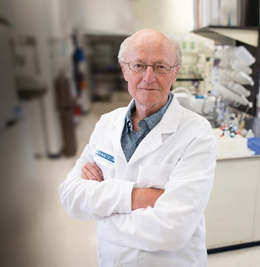 Vern Schramm, professor of biochemistry at Albert Einstein College of Medicine, Bronx, New York. Credit: Albert Einstein College of Medicine.
Vern Schramm, professor of biochemistry at Albert Einstein College of Medicine, Bronx, New York. Credit: Albert Einstein College of Medicine.
Enzymes drive life. Without them, we couldn’t properly digest food, make brain chemicals, move—or complete myriad other vital tasks. Unfortunately, in certain cases, enzymes also can trigger a host of health problems, including cancer, bacterial infections, and hypertension (high blood pressure).
Understanding how enzymes work has been the research focus of Vern Schramm for more than 4 decades.
“When we started our work, we were driven not by the desire to find drugs, but to understand the nature of enzymes, which are critical to human life,” Schramm says. But his research already led to one drug, and promises many more.
Continue reading “Block an Enzyme, Save a Life”PECASE Honoree Elizabeth Nance Highlights the Importance of Collaboration in Nanotechnology
 A network of capillaries supplies brain cells with nutrients. Tight seals in their walls keep blood toxins—and many beneficial drugs—out of the brain. Credit: Dan Ferber, PLOS Biol 2007 Jun; (5)6:E169. CC by 2.5
A network of capillaries supplies brain cells with nutrients. Tight seals in their walls keep blood toxins—and many beneficial drugs—out of the brain. Credit: Dan Ferber, PLOS Biol 2007 Jun; (5)6:E169. CC by 2.5
The blood-brain barrier—the ultra-tight seal in the walls of the brain’s capillaries—is an important part of the body’s defense system. It keeps invaders and other toxins from entering the human brain by screening out dangerous molecules. But the intricate workings of this extremely effective barrier also make it challenging to design therapeutics that would help us. And as it turns out, getting a drug across the blood-brain barrier is only half the battle. Once it’s across, the drug needs to effectively target the right cells in the brain tissue. With this in mind, it’s no surprise that challenges this complex are solved through collaboration among scientists from several different specialties.
Elizabeth Nance, an assistant professor of chemical engineering at the University of Washington in Seattle and a recent recipient of the Presidential Early Career Award for Scientists and Engineers (PECASE), focuses her research on understanding the barriers in the brain and other cell- and tissue-based barriers in the body to see how nanoparticles interact with them. Her lab uses nanoparticles to package therapies that will treat newborn brain injury, which can occur when the brain loses oxygen and blood flow, often during or immediately prior to delivery. This damage can lead to cerebral palsy, developmental delays, or sometimes death. Early interventions for newborn brain injury can be valuable, but they need to target specific, injured cells without harming healthy ones.
Continue reading “PECASE Honoree Elizabeth Nance Highlights the Importance of Collaboration in Nanotechnology”
